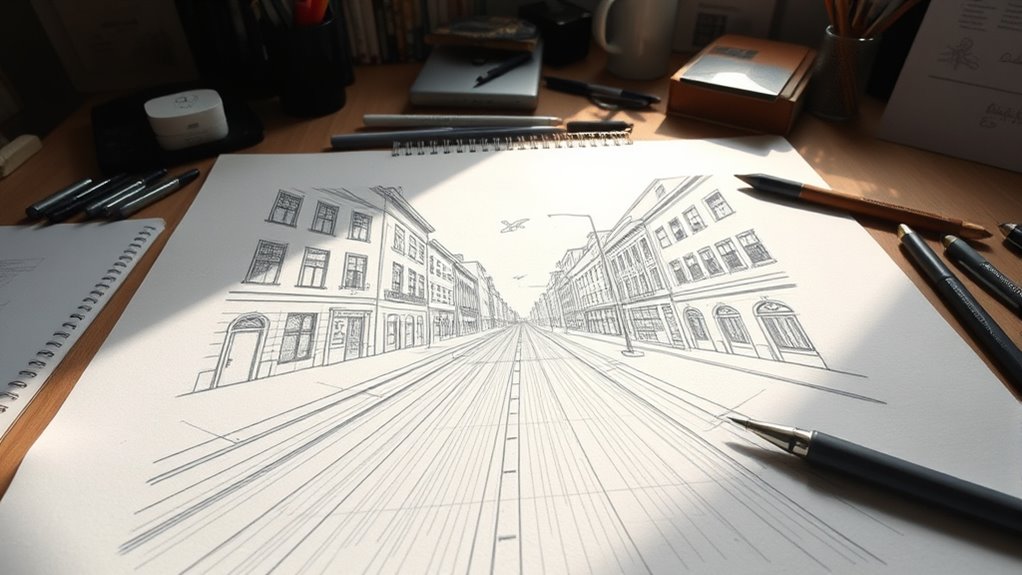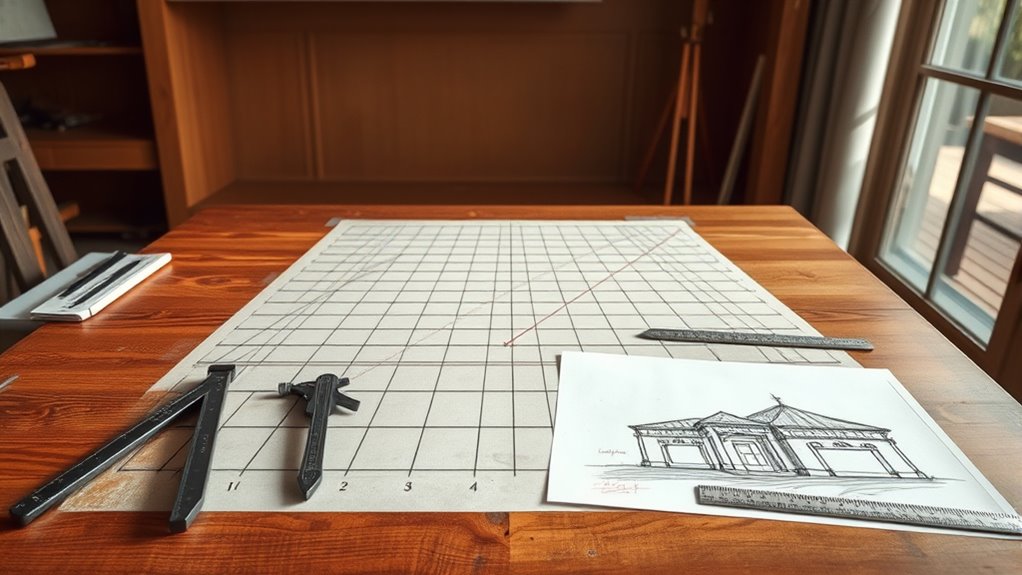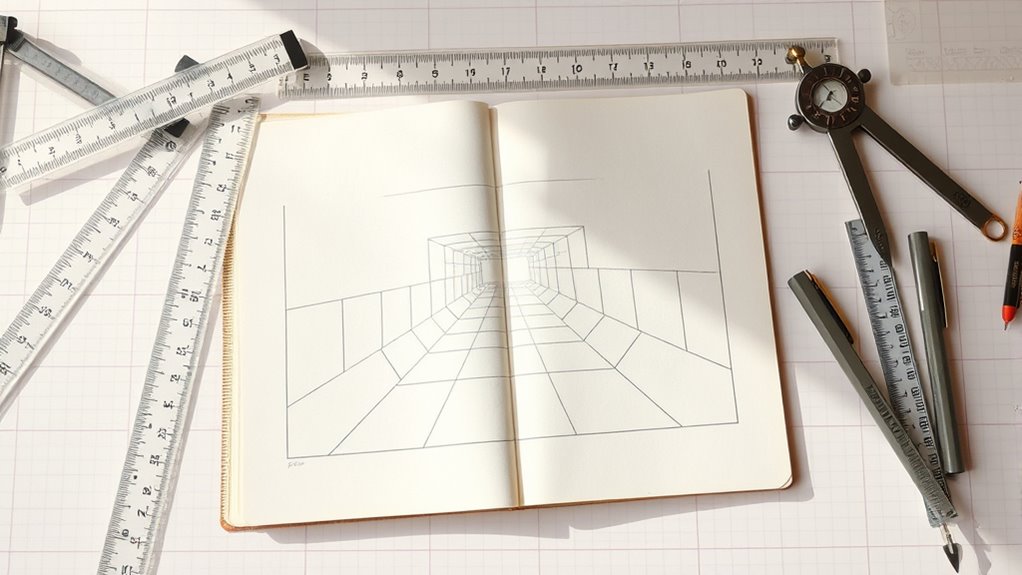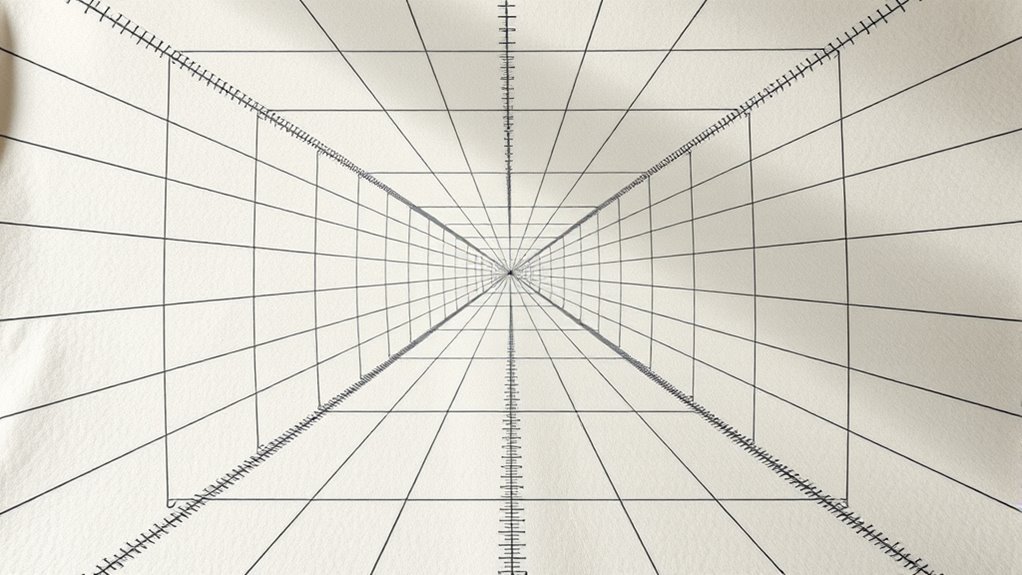The mathematics of perspective drawing involves understanding how vanishing points, horizon lines, and focal lengths work together to create depth on a flat surface. You’ll use geometric principles, ratios, and converging lines to mimic three-dimensional space accurately. By applying these concepts, you can control how objects diminish in size and appear farther away. Exploring these ideas further will help you master realistic compositions and spatial relationships in your artwork.
Key Takeaways
- Perspective drawing relies on geometric principles like vanishing points and horizon lines to create depth on a flat surface.
- Line convergence toward vanishing points models the way objects diminish with distance, governed by mathematical ratios.
- Focal length influences the position of vanishing points and the degree of perspective distortion in the scene.
- Perspective grids use geometric relationships to maintain proportionality and accurate scaling of objects at various distances.
- Understanding the mathematics of scale, ratios, and line convergence enhances the realism and spatial accuracy of drawings.
Understanding the Horizon Line and Eye Level

Have you ever wondered how artists create the sense of depth and realism in their drawings? It all starts with understanding the horizon line and eye level. The horizon line represents the viewer’s eye level and is where the sky meets the ground or water. When you position the horizon line higher in your drawing, it suggests a view from a lower angle, making objects seem smaller and distant. Conversely, lowering it gives a sense of looking up, emphasizing foreground details. Your eye level determines what you see and how you interpret spatial relationships. By accurately placing the horizon line and aligning it with your eye level, you create a foundation for realistic perspective, guiding how lines converge and how depth is perceived in your artwork. Using crochet techniques can also enhance your creative projects by adding texture and detail.
The Role of Vanishing Points in Perspective

You’ll see that multiple vanishing points help create realistic depth and dimension in your drawings. Each point guides the way lines converge, adding complexity to scenes with different angles. Understanding how these points work lets you craft more convincing and dynamic perspectives.
Multiple Vanishing Points
Ever wondered how artists create realistic images of complex scenes with multiple directions? Multiple vanishing points make this possible. When a scene has objects oriented in different directions, you need more than one vanishing point to accurately depict depth. The focal length of your camera or eye influences how these points appear; a longer focal length compresses the scene, reducing perspective distortion, while a shorter one exaggerates it. Artists use multiple vanishing points to maintain proportionality, even in complex compositions like cityscapes or interiors. Each set of parallel lines in different directions converges toward its own vanishing point, helping viewers understand spatial relationships. The use of perspective drawing techniques allows artists to convey realism, allowing you to convey depth and complexity effortlessly on a flat surface.
Depth and Dimension
Vanishing points serve as the foundation for creating depth and dimension in perspective drawing. They help your eye perceive space realistically, making flat surfaces appear three-dimensional. By aligning objects toward a vanishing point, you create optical illusions that trick your brain into seeing depth where there is none. This technique influences color perception as well; distant objects tend to appear lighter or less saturated, enhancing the sense of depth. Vanishing points guide the viewer’s eye, emphasizing spatial relationships and making scenes more convincing. Understanding how these points affect visual perception allows you to manipulate depth creatively, adding realism or surreal effects. Additionally, awareness of visual perception principles enables artists to refine their use of vanishing points for more impactful compositions. Ultimately, mastering vanishing points enables you to craft drawings that engage viewers with convincing, immersive three-dimensional worlds.
Exploring the Geometry of Perspective Grids

How do perspective grids create the illusion of depth on a flat surface? By using geometric principles, they guide your eye toward a vanishing point, mimicking how objects appear smaller as they recede. The grid’s lines help you understand focal length’s role in depth perception and foreshortening, where objects seem compressed. Consider this grid:
| Object Distance | Size Effect | Perspective Tip |
|---|---|---|
| Near | Larger, exaggerated | Use foreshortening for realism |
| Mid-range | Moderate size | Maintain consistent focal length |
| Far | Smaller, compressed | Align with vanishing points |
| Vanishing Point | Convergence point | Establish depth and scale |
| Horizon Line | Eye level reference | Anchor your perspective drawing |
Additionally, understanding the principles of perspective can enhance your ability to create convincing depth in your drawings.
Ratios and Proportions in Depth Representation

Ratios and proportions are fundamental tools in accurately representing depth in perspective drawing. You use proportionality ratios to maintain consistent relationships between objects’ sizes and distances, ensuring your drawing appears realistic. These ratios help you scale objects accurately, especially when creating scale modeling, where real-world dimensions are translated into manageable sizes. Understanding how proportions change with distance allows you to depict depth convincingly. For instance, as objects recede, their sizes diminish according to specific ratios, preserving spatial relationships. Mastering these proportionality ratios ensures your perspective remains consistent, making the scene believable. Additionally, recognizing how visual perception influences our understanding of size and distance can further improve your drawing skills. By carefully applying proportionality in your sketches, you achieve a harmonious balance between foreground and background, capturing depth precisely and enhancing the overall realism of your drawing.
The Mathematics Behind Converging Lines

You’ll see how vanishing points guide the way lines appear to converge in perspective drawings. Understanding vanishing point dynamics helps you accurately represent depth and distance. By mastering line convergence principles, you can create realistic images that draw viewers’ eyes toward a central point. Additionally, applying space optimization techniques ensures your compositions are both visually appealing and functionally effective.
Vanishing Point Dynamics
Vanishing points are fundamental in creating the illusion of depth and perspective in drawings, and understanding their mathematics reveals how lines converge realistically. The position of a vanishing point depends on your camera’s focal length: a longer focal length compresses space, making lines appear to meet farther away, while a shorter focal length exaggerates perspective distortion, causing lines to converge more quickly. As you adjust the focal length, the vanishing point shifts, altering the viewer’s sense of depth. This relationship explains why different lenses produce varied perspectives in photography and art. Recognizing how focal length influences vanishing point placement helps you control the convergence of lines, ensuring your drawings accurately mimic real-world perspective and maintain visual coherence. Additionally, understanding tuning Hyundai vehicles can provide insight into how precision adjustments affect overall performance and handling.
Line Convergence Principles
The mathematics behind line convergence reveals how parallel lines appear to meet at a single point in perspective drawing. This convergence occurs because of perspective distortion, which skews how we perceive distance and angles. When you draw lines receding into space, their angles relative to your eye are divided by angle bisectors, guiding how they seem to meet at the vanishing point. These bisectors help determine the correct convergence, ensuring realistic depth. Understanding this process allows you to control the visual effect of depth and spatial relationships. As lines move farther away, their angles adjust according to these principles, creating the illusion that they converge at a single point in space. Additionally, regional knowledge of local drawing conventions can influence how you apply these principles in different artistic contexts. Mastering line convergence ensures your drawings accurately depict three-dimensional space on a flat surface.
Calculating Distance and Scale in Perspective

Understanding how to calculate distances and scale in perspective drawing is essential for creating realistic and proportionate images. Accurate scale calculation helps you replicate objects in correct proportion, while distance estimation determines how far away elements appear. To do this effectively, you can use geometry and vanishing points. Additionally, considering color accuracy and how it affects visual perception can enhance the realism of your drawings. Here’s a simple guide:
| Object Size | Distance from Viewer | Scale Factor |
|---|---|---|
| Larger | Closer | Higher |
| Smaller | Farther | Lower |
| Same size | Same distance | Same scale |
| Half size | Half distance | Half scale |
| Double size | Half distance | Double scale |
The Influence of Multiple Vanishing Points

When drawing objects with multiple directions, using more than one vanishing point allows you to create images with greater realism and depth. This technique, called multi-point perspective, captures how our eyes perceive complex scenes, enhancing spatial perception. With multiple vanishing points, you can accurately depict buildings and interiors that turn in different directions, avoiding the distortion seen with a single vanishing point. Each vanishing point represents a set of parallel lines receding into space, helping you organize the composition and simulate three-dimensionality. This approach increases the viewer’s sense of immersion, making scenes more convincing. By understanding how multiple vanishing points influence the convergence of lines, you gain better control over how depth and spatial relationships are communicated in your drawings. Incorporating techniques from wall organization systems can also help in planning and structuring complex scenes for more precise perspective rendering.
Using Mathematical Models to Construct Perspective Drawings

Mathematical models provide a precise framework for constructing perspective drawings by translating three-dimensional scenes into two-dimensional images. By using coordinate systems and geometric principles, you can accurately depict depth, scale, and proportions. These models help prevent optical illusions that can distort perception, ensuring your drawing maintains realistic spatial relationships. Incorporating color theory into these models allows you to enhance depth and atmosphere, guiding viewers’ focus and mood. You can also analyze how colors interact with perspective lines, creating visual effects that reinforce spatial cues. With mathematical models, you gain control over perspective construction, making complex scenes manageable. This approach not only improves accuracy but also deepens your understanding of how visual elements work together to create convincing, compelling images.
Applying Perspective Principles to Complex Scenes

Applying perspective principles to complex scenes requires careful planning and strategic use of geometric cues to manage multiple elements within a single composition. You need to contemplate focal length, which affects how objects appear in terms of size and depth, helping you control the scene’s overall sense of space. When dealing with multiple subjects at different distances, perspective distortion can occur, making some objects appear exaggerated or skewed. To minimize this, you should adjust your viewpoint and focal length thoughtfully. Use vanishing points and converging lines to organize the scene effectively, ensuring all elements relate cohesively within the perspective framework. By balancing these factors, you can create realistic and compelling complex scenes that maintain depth and spatial accuracy.
Frequently Asked Questions
How Does Perspective Drawing Relate to Real-World Physics?
In perspective drawing, you see how visual cues mimic real-world physics, like how light refraction bends light and creates optical illusions. You use principles of physics to accurately represent depth, distance, and scale on a flat surface. By understanding how light interacts with objects and the eye, your drawings can create convincing illusions, making viewers believe they’re seeing a three-dimensional scene that obeys the same physical laws as the real world.
Can Perspective Principles Be Applied to Digital 3D Modeling?
Imagine perspective principles as a map guiding your digital 3D modeling. You can definitely apply concepts like vanishing points and horizon lines to create realistic scenes. These tools help you establish depth and scale, making your models feel like they exist in a real-world space. By understanding how perspective works, you can craft more convincing environments, ensuring every element aligns perfectly with the viewer’s eye and enhances immersion.
What Are Common Mathematical Errors in Perspective Drawing?
When you draw perspective, you often stumble over common mistakes like misplacing vanishing points or incorrectly aligning horizon lines. These errors can distort your scene and make objects look unnatural. To avoid this, double-check that all lines converge accurately at the vanishing points and verify the horizon line is level. Paying close attention to these details helps create realistic, proportionate drawings that follow proper perspective rules.
How Does Perspective Change With Different Observer Heights?
Ever wondered how your viewpoint shifts when you change your height? As an observer, your eye level determines the placement of vanishing points in your perspective. When you stand higher, the horizon rises, and vanishing points move accordingly, giving a different sense of depth. Conversely, lowering your height lowers your eye level, altering the vanishing points and how objects appear to recede. Your perspective adapts dynamically based on your vantage point.
Are There Software Tools That Automate Perspective Calculations?
You’re wondering if there’s perspective software that automates calculations. Yes, many tools are available that streamline perspective drawing by providing automated calculations. These programs help you create accurate scenes quickly, adjusting for different angles, heights, and vanishing points. With perspective software, you don’t need to do complex math manually—just input your parameters, and the software handles the rest, making your workflow faster and more precise.
Conclusion
Understanding the mathematics behind perspective drawing is like revealing a secret code that transforms flat sketches into lifelike scenes. By mastering vanishing points, ratios, and geometry, you can create depth that feels almost three-dimensional. Think of perspective as the backbone of realistic art—without it, images are flat and disconnected. When you grasp these mathematical principles, your drawings become as natural and seamless as breathing, bringing your visions vividly to life.









